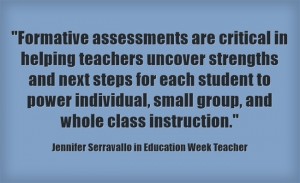 Assessments are such an important part of a classroom. Typical assessments are homework assignments, quizzes, and papers. All of these assignments are ways for faculty to check their students’ understanding. These assessments also provide students with feedback about their work and understanding. Assessments can happen formally, (see examples stated above) or informally. Informal assessments look like exit cards, thumbs up or down, checklists, 3 minute writing sample, and more. Rebecca Alber, an Edutopia consulting online editor, states, “Informal, or formative assessments are about checking for understanding in an effective way in order to guide instruction. They are used during instruction rather than at the end of a unit or course of study. And if we use them correctly, and often, yes, there is a chance instruction will slow when we discover we need to re-teach or review material the students wholly ‘did not get’ — and that’s okay. Because sometimes we have to slow down in order to go quickly.” Below are explanations of the informal assessment Rebecca suggests:
Assessments are such an important part of a classroom. Typical assessments are homework assignments, quizzes, and papers. All of these assignments are ways for faculty to check their students’ understanding. These assessments also provide students with feedback about their work and understanding. Assessments can happen formally, (see examples stated above) or informally. Informal assessments look like exit cards, thumbs up or down, checklists, 3 minute writing sample, and more. Rebecca Alber, an Edutopia consulting online editor, states, “Informal, or formative assessments are about checking for understanding in an effective way in order to guide instruction. They are used during instruction rather than at the end of a unit or course of study. And if we use them correctly, and often, yes, there is a chance instruction will slow when we discover we need to re-teach or review material the students wholly ‘did not get’ — and that’s okay. Because sometimes we have to slow down in order to go quickly.” Below are explanations of the informal assessment Rebecca suggests:
Exit Slips
These can be fun and not daunting, for students or teacher. Give students a question to answer that targets the big idea of the lesson, and have them write a sentence or two. Stand by the door and collect them as they leave. Sit at your desk and thumb through them all, making three stacks: they get it, kind of get it, and don’t get it all. The size of the stacks will tell you what to do next.
Student Checklist
Give your students a checklist and have them self-assess. Collect the checklists with each, or every other, new idea during a unit of study. Make sure they write a sentence or two explaining how they know they’ve got it, or why they think they are still struggling.
The Three-Minute Paper
This is more involved than the exit slip and often times, I’d give the kids more than three minutes. I don’t use the word “essay” or they get too nervous. I might say, “Take out a piece of paper, and tell me what you have learned so far about ____________.” Often they will basically write an essay (something they usually labor over in drafts and on their own!) I assess these the same way as the exit slip, by making the three stacks.
One-Sentence Summary
Ask students to write a summary sentence that answers the “who, what where, when, why, how” questions about the topic.
Misconception Check
Provide students with common or predictable misconceptions about a specific principle, process, or concept. Ask them whether they agree or disagree and explain why. Also, to save time, you can present a misconception check in the form of multiple-choice or true/false.
To read more about Rebecca’s informal assessment article, click here.
